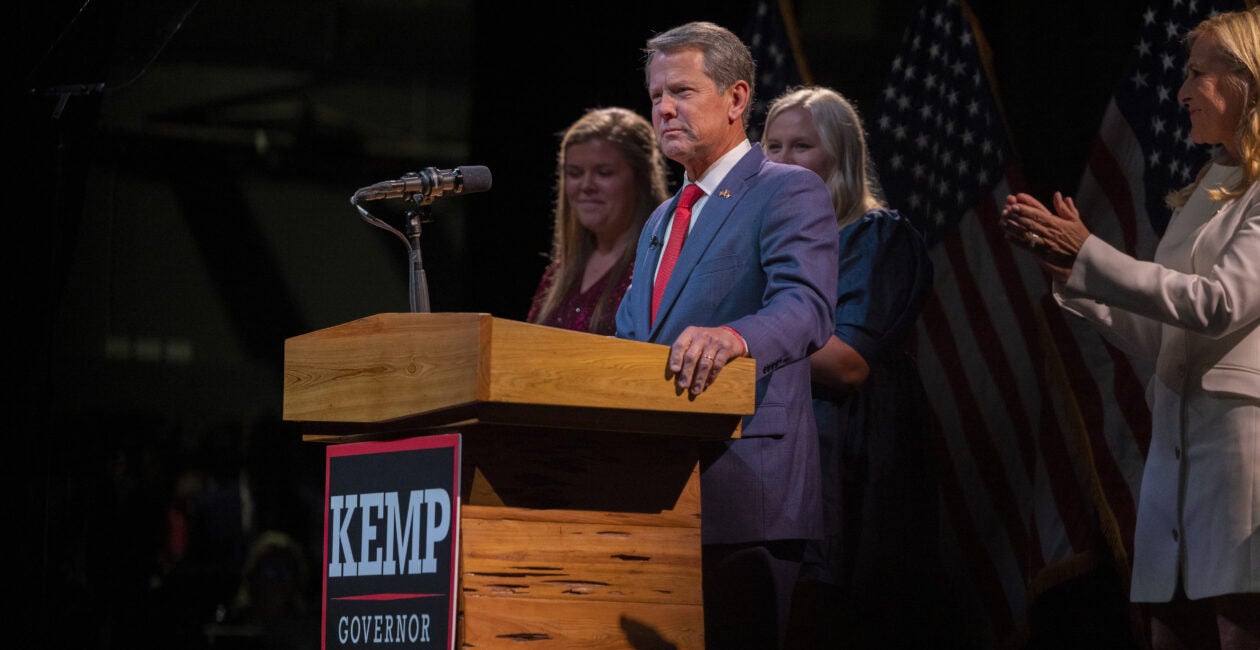You’d think that Georgia Gov. Brian Kemp would be getting more national attention, given his solid record of conservative accomplishments. But if he wants to be touted as an exemplar of conservative governance, he needs to fill one gaping hole in his otherwise sterling résumé: school choice.
Since he was elected governor in 2018, Kemp has signed into law a “heartbeat” act that prohibits the taking of unborn life after about six weeks of pregnancy, the largest income tax cut in Georgia history, and a “constitutional carry” law protecting Georgians’ right to bear arms.
But Kemp’s done more than just sign bills into law. He’s also shown how to govern as a conservative.
The Daily Signal depends on the support of readers like you. Donate now
Georgia was the first state to open businesses and schools after the COVID-19 shutdowns. He cut government spending when the pandemic recession hit and maintained some of those cuts after revenue flowed in when the state reopened. Even after the recession ended, state spending adjusted for inflation and population growth is lower this fiscal year than in 2008.
Because of his fiscal prudence, Georgia has had annual budget surpluses that exceed $6 billion. Kemp has been using many of those surplus dollars to build the state’s rainy day fund and to give tax rebates to hardworking Georgians. For 2023, his budget proposals call for another $1 billion property tax rebate and another $1.6 billion income tax rebate.
Kemp has also led on fighting crime. He successfully cracked down on gangs and is now proposing legislation to allow for the removal of rogue left-wing prosecutors who refuse to do their jobs and prosecute those who break the law.
All this should make Kemp a very attractive national leader for conservatives, but the fact that his résumé is lacking on school choice isn’t helping him. Over the last few years, school choice has emerged as a litmus-test issue for Republican primary voters.
In a poll of likely voters nationwide last fall, 81% of Republican voters supported school choice policies. Last March, GOP primary voters in Texas registered higher support for a pro-school choice ballot proposition (88%) than a pro-life one (83%). Likewise, a poll of Republicans in Oklahoma also found higher levels of support for school choice (78%) than for pro-life policies (68%).
Republican voters have demonstrated their desire for school choice at the ballot box. The GOP primary candidates endorsed by the pro-school choice American Federation for Children Action Fund in 2022 won in 85 out of 115 races. In 40 races, a pro-school choice challenger replaced an anti-school choice incumbent.
Several Republican governors have led on this issue. In Iowa, Gov. Kimberly Reynolds went all in on school choice, spending her political capital to support primary challengers to Republican state legislators who had thwarted her school choice proposal last year.
Iowa voters backed her candidates and rewarded her with a resounding reelection victory and larger GOP majorities in both chambers of the Legislature. Last month, Iowa enacted an education choice policy that will be available to all K-12 students within three years.
Similarly, Gov. Ron DeSantis in Florida, Gov. Greg Abbott in Texas, Gov. Sarah Huckabee Sanders in Arkansas, and Gov. Kevin Stitt in Oklahoma have all proposed ambitious policies to empower families to choose the learning environments that align with their values and work best for their children.
States like Arizona, Iowa, Utah, and West Virginia are now allowing all families to take state tax dollars to the school or educational setting of their choice.
What has Kemp done to empower Georgia families with education choice?
Kemp signed a modest expansion to the state’s tax credit scholarship program that encourages taxpayers to contribute to nonprofits that grant scholarships for students whose families want them to attend a private school.
About 1% of Georgia K-12 students receive scholarships. The expansion raised the annual tax credit cap by $20 million, which is less than one-tenth of 1% of what taxpayers spend on Georgia public schools.
The scholarship program saves the state tens of millions of dollars per year, so Kemp’s tepid support for its expansion is inexplicable.
During the 2021-22 school year, Georgia public schools spent a record $26 billion—$3 billion more than the school year before the pandemic. Since that time, Kemp has proposed giving them billions more. Those dollars would be better spent if given to parents directly.
Kemp has an opportunity to burnish his résumé by throwing his weight behind a proposal to give all K-12 students in Georgia access to education choice.
Senate Bill 223 would create K-12 education savings accounts worth $6,000 annually that families could use to pay for private school tuition, tutoring, textbooks, homeschool curriculum, online courses, special-needs therapy, and more. With education savings accounts, families are empowered with the freedom and flexibility to customize their child’s education.
Kemp and his advisers appear to be betting his future on clinging to support from public school employees in Georgia. Meanwhile, other red state governors are betting on giving families more publicly funded K-12 educational options. School choice advocates are waiting to see which strategy prevails.
Have an opinion about this article? To sound off, please email letters@DailySignal.com, and we’ll consider publishing your edited remarks in our regular “We Hear You” feature. Remember to include the URL or headline of the article plus your name and town and/or state.




























